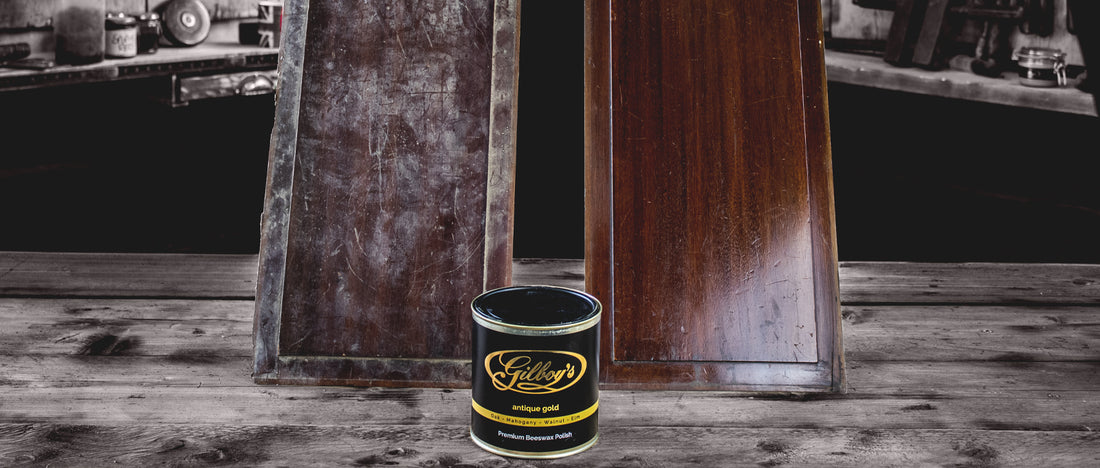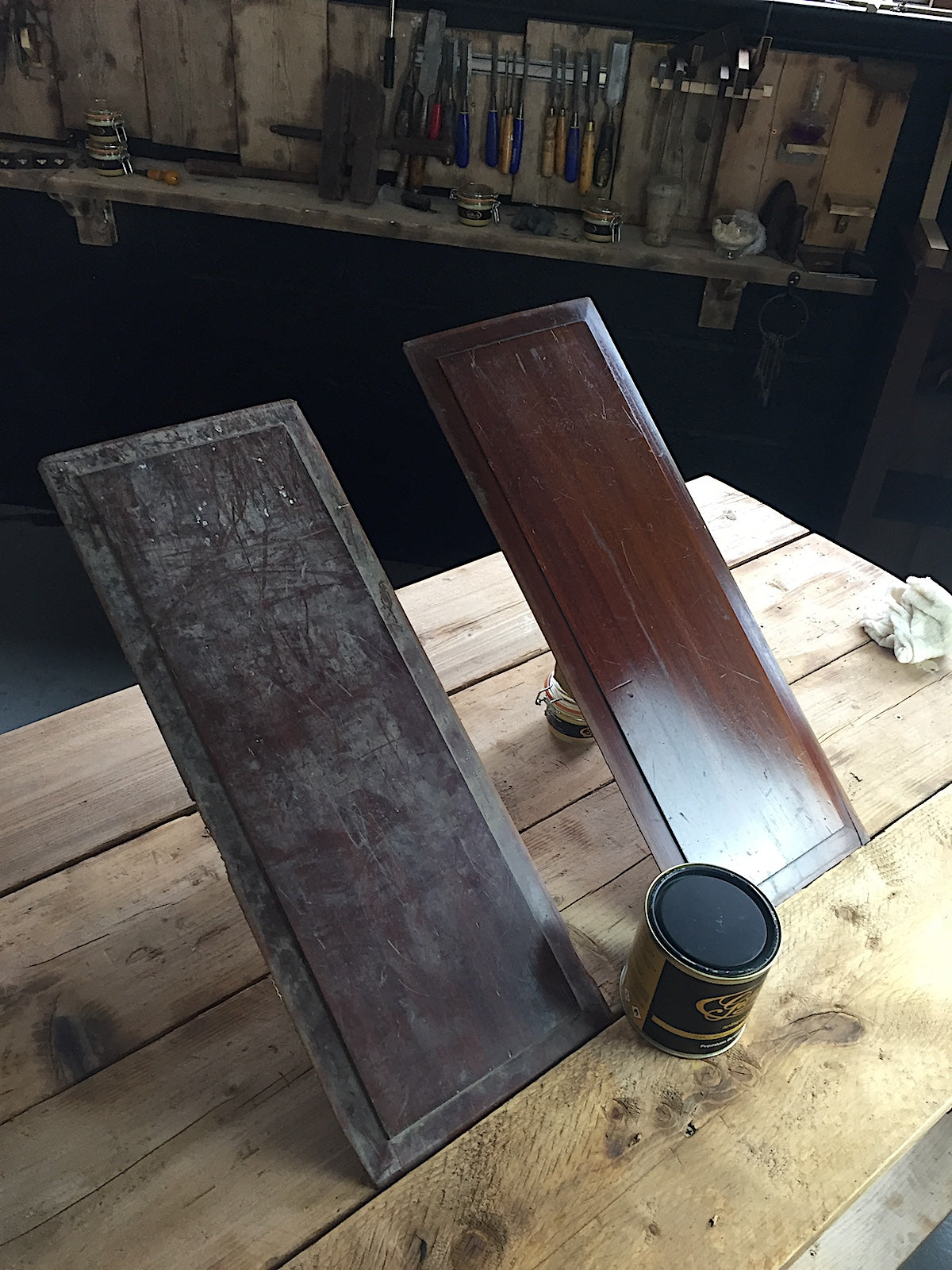
Polishing Antique Furniture with Beeswax Polish: Before & After, Side-By-Side Comparison
Simon GilboyShare
TL;DR [scroll down for video]
I was rummaging around in the container just outside here. We have a large shipping container where we store all of our bits of old furniture that we use for repairs. And I stumbled across these two panels. Now look at these, two mahogany panels that are identical.
I'm going to wax one and leave one. So we've got a before and after. People are always asking us about our polishes and why they're so good and why we as furniture restorers make them.
Why do we make the polish?
Well, it was for reasons I hopefully can show you live in front of the camera because other polishes really didn't cut the mustard. Not really, not with the quality of our restoration, the quality of the furniture. This is why we made our polishes; our wax polish, Gilboy's Gold was made using the best ingredients. Anyhow, I'm going to show you how we would do it here in the workshop. I'm not going to clean it. I'm not cleaning this first. I'm gonna go straight on with the wire wool with the wax on it. The wire wool is going to remove the dirt. Apply the wax, we going to leave it for 20 minutes. Come back and buff. Hopefully the evidence between the two will be quite clear.
How to apply beeswax polish with wire wool
Soft wire wool. You can buy it on our website. Oil-free wire wool. No petrochemicals in it. Again some antique gold. Just scrubbing into that wire wool there. Not much left in me tin, we used it all up! Right, I'm going to apply it straight to the panel.
Okay. It probably sounds worse than it is on that microphone and it probably sounds really scratchy but I promise you it's not. It's soft like cotton wool. What it does is removes the dirt. I'm not trying, I don't want to over-apply, I've got a bit too much there. I want a thin layer. We put so much, such a high content of raw ingredients in our waxes unlike the other manufacturers, we don't skimp. There's T1 grade carnauba wax in there. Beeswax from Buckfast Abbey, which is organically farmed. The principles they use - no pesticides in their beeswax. Myrica wax which adds extra protective UV and hardness and resistance. Pure pine turpentine just like they traditionally did in Georgian times Chippendale period. Look at that. Getting in there.
I'm just going to take a little bit off, a little bit too much there. There's the wax applied. And there it is. The original panel. I'm going to wait 20 minutes or so. We'll come back and buff and we should have a nice before and after and a clear evidence of why Gilboy's Gold is better than the rest.
How to buff beeswax polish to a deep lustrous shine
Right. So we waited 20 minutes and now we go for the buff. Reminder again. Wax. When it's waxed, here's little point about waxing, when you're waxing something it's probably quite good to do a small area like this, especially with our wax because it's so rich in its content. You don't want to do a huge area and then come back and be buffing, buffing and buffing. I mean it's easy to buff but blindly when you do a large area, you're making work for yourself. Do small areas at a time, if there's a dining table do one leaf. A chair, a single chair, don't do three chairs. The side of a chest of drawers.
The other thing I was going to say was, actually when you are applying wax, when you get it nice and evenly applied, the surface will go matte. You get a sort of satin matte sheen to the surface. You can't see any shiny areas, any areas that you've missed. It would be like a dull matte coating over the surface with no lumps and bumps on it because the wire wool applies it nice and evenly.
So, let's go for the buff. I'm going to move that to one side and maybe. I wonder if I can hold it and buff it. Let's see...
It looks great doesn't it? I still smile because I'm amazed that we've made such a really good wax and we're just furniture restorers French polishers. We know what we're doing when it comes to furniture restoration. But when it came to making wax in the first place we didn't really know. We just thought we'd get the best ingredients and really go for it and start at the top rather than working at the bottom and see what we can get. And this is what we can get.
Look, and there's nothing coming off of this as an old piece of our pure cotton cloth that we use for buffing, we also use it for staining, we use it for all sorts of things, it's just brilliant stuff. I haven't gone out and got a new piece, this has been in the workshop on the bench over there and you can hear it. It just glides across the surface. That's because it's such a rich content. The other reason we use this pure cotton cloth as opposed to a duster or anything else or a rag is because it's got a nice open weave. If I open that up... If you can see that, there's a nice open weave to the cotton and that open weave, that stops the surface from getting too hot. When you're buffing therefore it doesn't heat the wax and doesn't get smears and that's the reason we have this cotton cloth, because it doesn't smear the surface it doesn't heat the surface up. You'll see me changing, turning it over, as if it does stop. Feels like it's getting warm especially around these sort of edges here. You turn the cloth around.
The before and after, side by side comparison
There would’ve been a frame around this. This panel. This floating panel would have been inside a sort of fielded panel. In the middle of this there's a mark or something that I don't know. I have no idea, look.
There's your before. One application of Gilboy's antique gold. There's your after. Look at that. We're almost doing ourselves out of a job!

That's brilliant isn't it? [chuckle]. It's really good. So you could if you wanted to, apply another wax coating of our wax to it but not straight away because it's just going to dissolve into what you just put on there. Leave it for a few days. Let it go hard, let the pure turpentine evaporate. Pure natural pine turpentine as opposed to petrochemical. No oil in there so there's no massive petrochemicals and oil. You don't want oil going into really going into your wood surfaces because it breaks it down. That's why we use the pine turpentine, and it's true of traditional recipes for expensive stuff but it's brilliant. We'll take some photos of these and put them on our website so you can see them. Well that's a genuine before and after of two pieces of mahogany I've just found in a container.
I nearly forgot... Please subscribe to our YouTube channel. Hit the subscribe button and click the little bell for notifications so you get notifications when we upload a new video which we hopefully will be doing continually. Now with more and more videos, helpful hints and tips on furniture restoration, French polishing, colouring, anything to do with furniture repair. Hopefully over these coming months (and years) we'll build up lots of videos.
| Beeswax Polish in Jars | Complete Polishing Kits | 1L Tins |
 |
 |
 |
